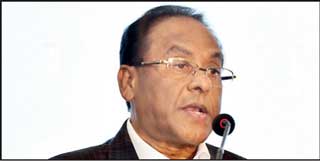Sunday Dec 14, 2025
Sunday Dec 14, 2025
Friday, 8 September 2023 00:20 - - {{hitsCtrl.values.hits}}
 |
| M. Shantikumar |
By Charumini de Silva
Industry leader M. Shantikumar expressed a positive outlook for the country’s hotel industry, with a significant surge in reservations for the upcoming winter season.
His remarks come as a beacon of hope for the hospitality sector, which has faced multiple challenges in the past three years.
“We have noticed a steady uptick in reservations, exceeding the levels seen in the past three years or in months in 2023,” The Hotels Association of Sri Lanka (THASL) President told the Daily FT.
As per him, the inquiries for reservations have predominantly originated from countries such as India, the UK, Europe, Russia and China indicating a diverse international interest in Sri Lanka as their winter holiday destination.
With the winter season approaching, Shantikumar predicts that hotel occupancy across the country will remain steady, not falling below 70%.
“This surge in occupancy is a promising sign for the industry, as it reflects a resilient rebound from multiple challenges faced in recent years as well as a strong desire for accommodation in Sri Lanka ahead of the impending winter holidays,” he added.
THASL Chief also highlighted the forthcoming introduction of a minimum room rate (MRR) starting next month, which is poised to further boost the hotel industry’s turnover and economy. “This move is expected to have a cascading effect, benefitting the staff with higher service charges, improved salaries, enhanced turnover, and ultimately contributing to the welfare of stakeholders and the broader economy. The President’s vision is to build up Sri Lanka as a most preferred destination catering to the high-end tourists,” he said.
Last month Sri Lanka Tourism authorities announced the return of the MRR regime from 1 October 2023.
The move is considered a lifeline for the city hotels that were struggling but will come with strict penalties if found to be violating. The MRR structure has been meticulously defined to accommodate different hotel categories: $ 100 for 5-star hotels, $ 75 for 4-star establishments, $ 60 for 3-star accommodations, and $ 50 for others. However, special provisions will be made for rates applicable to Meetings, Incentives, Conferences, and Exhibitions (MICE) travellers, recognising the unique nature of such events.
Shantikumar expressed optimism about the potential benefits of the MRR for all stakeholders involved in the tourism industry. “Looking ahead, hotels in Colombo city hotels would experience an impressive 18% surge in demand from October onwards. The upswing is expected to be driven by a mix of business travellers and holidaymakers in the last quarter of 2023, further boosting the tourism sector,” he said.
Reinforced by this outstanding demand for Sri Lanka as a travel destination, Shantikumar expressed his confidence in ending the year with over 1.5 million arrivals, underscoring the country’s resolute resurgence in the global tourism landscape.
Sri Lanka received 11,737 tourists on the first three days of September, bringing the total to 916,055 so far in 2023. With 173,377 tourists a year to date (YTD), India remains the single largest source market, followed by Russia with 125,837, the United Kingdom with 84,252, Germany with 62,432 and France with 41,549 tourists.
One of the overarching goals outlined by Shanthikumar is to elevate the average daily spending of tourists. At present $ 180-185 is the average daily spending of travellers and the authorities are keen to increase it to $ 300 per day, with a long-term objective of reaching $ 500 by 2030.
He also said the launch of the short-term global communication campaign will further improve visitor interests and occupancies countrywide.